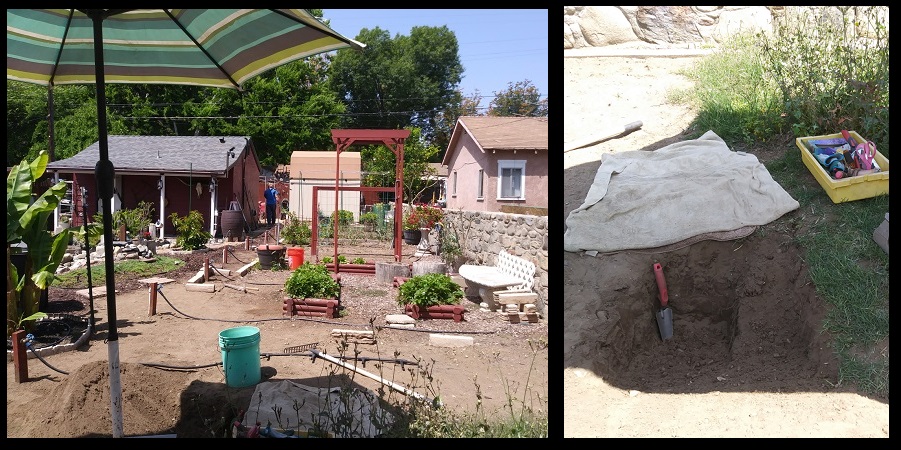**Warning: Anne is going to talk about gardening again, you have our permission to skip this Blog, LOL.
Spring is the obvious time for most of us to be outside doing yardwork. If you can’t tell by looking outside, you can tell by all the television advertisements for yard maintenance stuff. The weeds already have a head start, and it seems by the time you notice one, there are millions of them everywhere! For now, I’m ignoring the milkweed and letting them grow. Milkweed is supposed to be good for butterflies and bees, but what I’m actually seeing on the milkweed is lots of ladybugs, and I want them to stick around to help me in the garden. I’ve started tomatoes and cucumbers, the lettuce and strawberries are going strong and I have lots of seeds and seedlings waiting for me to put them in the ground!
Most importantly, this is my 4th and (hopefully) final year in my plan to eliminate the Bermuda grass from my back yard. Oh you may laugh, ho ho, and say, “Anne, it’s impossible to eliminate Bermuda grass!” and you would be right. I will never totally eliminate the Bermuda, but now I think I can see the light at the end of the tunnel!
We have lived in this house for about 38 years. The Bermuda grass was there before we moved in. Someone probably planted it on purpose, Bermuda is a popular choice for a tough, heat loving, drought tolerant lawn. Over the years, any effort on my part to plant a garden or flowerbed has been thwarted by Bermuda grass running into it and choking out everything else. Bermuda is a survivor….it has 3 ways of spreading, and it spreads fast!
1) Seeds that blow in from other areas or carried by birds or other animals
2) Spreads across the ground surface
3) Spread by tough, thick stems that go deep underground.
I’ve tried many organic (and non-organic) methods of eradicating Bermuda. After so many years of trying, I got tired of waiting for my dream-garden-food-forest so I decided to start digging! I had to eliminate all of the stems that were underground because any piece of a stem left in the dirt can grow roots and start a new patch of Bermuda. The new seeds that sprout from the top are easily pulled out annually with the rest of the spring weeds, but what happens underground becomes a big problem!
Every year for the past 4 years, I’ve spent my “home time” (the very brief amount of time we actually are at home between concert tours) planting, harvesting and pushing back the Bermuda. I sit under my trusty umbrella (5 square feet of life-saving shade!) I push the Bermuda back, and I plant garden rows in its place, with a generous mulched area in-between so I can watch for new patches of Bermuda that might appear from below.

Looking at the picture on the left, Jim (blue shirt- working on irrigation) is standing by the tan-colored barn. The little red house on the left is a utility/laundry room. Bermuda eradication started at the barn, and now the only Bermuda that remains is the small patch in the foreground with the milkweed. The picture on the right shows how deep I have to dig to get the stems out from underground. So far I’m lucky, I haven’t found many stems going deeper than 1 foot (but google says it can go underground up to 3 feet! Yikes!).
I am happy to see the end of this chore. I would like to focus all of my time and attention on growing food and truthfully, at my age and into the future I won’t have the strength to be pushing around so much dirt! It’s good though, to set a goal and see it through. Even though it took a very long time to figure out HOW to do it, there is a lot of satisfaction in getting it done.
Are you working on a project that you’ve been dreaming about? Let me know about it in the comments!



Connie and Margie bought the last 4 pallets of pavers from a local business moving out of state. Margie got her front driveway expanded. I, on the other hand, have the pavers still stacked in the backyard. When I die my to-do list is still going to be 2 pages long.
Yes, Connie – you and I will not have enough time in the world to do the things we want to do….best get started NOW!! Haha!! But maybe start with something more fun than installing pavers…
I feel your pain. That grass is a pain to get rid of. I had it years ago and had to use Roundup.
It is NOT as bad as they say. You just have to be careful and read the directions. I got rid of all the grass. But after 7 or 8 years I replaced it with fake grass. Looks great next to the pool. No grass in the pool!
Take care,
George
Sounds beautiful George – and super low maintenance! I will be headed in that direction when I’ve had my fill of farming (if ever) except without the pool! I shudder to think what artificial turf might cost in my big backyard!
Hi Anne,
I love your story.The Battle Of Bermu
ad
Hi May! Thanks!
Hi Anne, I can completely understand about getting rid of your Bermuda grass and how difficult it is to do it. Here in PA, we have zoysia grass which is the equivalent of your Bermuda grass. Zoysia grass has very deep roots and like Bermuda grass, it is very difficult to remove it. In addition, when it is winter here, the zoysia grass looks like straw because of the cold weather, which I dislike very much. When I moved here in 2004, I didn’t have zoysia grass, but as the years passed, it crept into my garden from the neighbors’ yards. I try to remove it in my fenced perrenial garden, but I can’t remove it from the rest of my backyard because the process is too difficult and expensive and I don’t have anyone to help me. I am glad you had success with your grass and I hope it doesn’t come back. Happy gardening. I hope to see you and Jim in concert one day soon.
Hi Diane, I know what you mean and I’m sorry to hear about your Zoysia! I’ve been thinking a lot about my health and strength declining in my older years, so I’m very glad I am digging out Bermuda now – don’t think 5 or 10 years into the future I will have the strength or the gumption!
Anne, Sydney and I are so thrilled we purchased tickets for the CA concert. I hope we can see you and the group after the performance !
So sorry about your struggle with the Bermuda grass!
Happy garden growing,
Irene
I Irene! We will be out in the lobby after the show! If you have time – come by and say hello!
Moved from Altadena to Santa Barbara. Why don’t you perform at the Granada Theater??
They have great shows. You would be one of the best!!
Hi Julia, We just got booked to perform at the Grand in Santa Barbara next year! Serendipity!
Hi Anne, enjoyed your story about the garden and Bermuda grass!! If we have it here in Illinois, it travels perhaps by a different stage name…..lol had my first experience with poison ivy last year in my backyard, we have been here 45 years and never had it. I pulled the goofy thing out with my bare hands and suddenly in horror realized what it probably was. A fast trip into the house to wash hands for ten minutes and returned with sensible gloves to finish the job. I was lucky.
Haven’t started much yet. It’s been a cold and rainy spring so far in Illinois, supposed to change soon. We had snow into mid April. But spring flowers were numerous and great. It should be time to get my geraniums going. Off to the greenhouse soon, I hope. Yours in trying to negotiate Mother Nature!! Take care!!! Pam
Hi Pam! I hope you are now enjoying your time in the greenhouse! We are full-on growing now, we have to get what we can before the summer heat burns it all up! Thanks for the poison ivy story, thankfully we don’t have to deal with that!